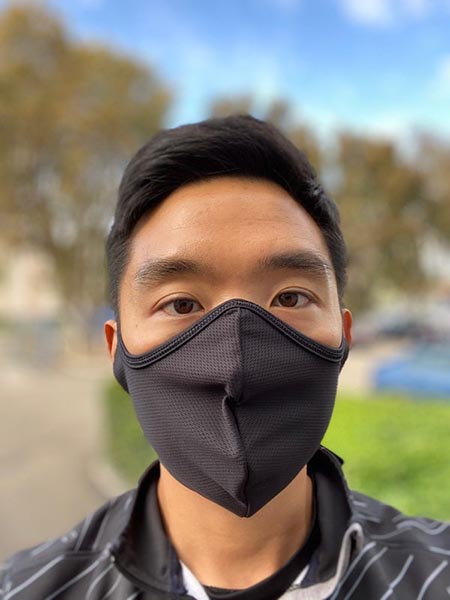We first introduced you to teen fashion designer Ariel Swedroe in October of 2018. Her story was inspiring then, and she continues to inspire us today. Ariel is just one of many that is turning her skills and passions into active support for fighting the virus. Not only is she using her sewing skills to produce masks, she has posted a how-to tutorial on Instagram so others can pitch in as well.
Other companies are retooling their operations to make masks as well as keep people employed. We spoke with Patrick Tio at Equipe Athletics in Southern California who has two styles of face mask that meet the current CDC guidance in the event of a shortage of certified face masks during the COVID-19 outbreak. He selected fabric, a 100% polyester Fleece, based on a study published by the Oxford University Press who did a materials study against aerosolized particles. The facemask has been developed with the user’s comfort in mind with contouring in the face to ensure a good fit as well as reduce leakage to the greatest extent possible. The ties are polyester spandex which can be fully adjusted and will stretch to accommodate a wide range of sizes. Masks can be purchased via the Equipe Athletics website with volume discount pricing. He tells us, “But if masks need to go to an individual in need, we are also donating. For larger organizations looking for donations, we are requesting they help offset our material and labor costs. We are also doing this to help my staff stay employed during these hard times. In the first week, his team started producing 800 masks per day and were able to quickly ramp up to 1,500 per day.

Even our own Kelley Holmes is devoting time to making masks. She says, “Home Economics was a long time ago but the skills come back. By the way, did you know that the N95 3M mask is made from the same fabric in the virus AC filter #10? Consider changing your AC filter!”

On a larger scale, Gerber Technology has created a PPE Task force and Resource Team to support its global base of customers and partners as they work to increase their production or transition to manufacturing personal protective equipment (PPE). The company states, “In a global context where COVID-19 inexorably continues to spread, the global shortage of masks and other personal protective equipment needed to keep healthcare workers safe is a concern of everyone.”

The Gerber PPE Resource Team is available to support PPE manufacturing including:
- Implementing pre-defined patterns and markers or defining fabric/sewing requirements.
- Helping with the setup of cutter parameters specific to the selected fabrics.
- Providing training, software, equipment and service technicians to ramp up production.
- Changing over current production lines to the production of PPE.
- Connecting supply and demand for PPE via our global ecosystem of customers and partners.
- Introducing existing PPE manufacturers to those converting to PPE production.
In the first 48 hours, the task force received 240 requests from customers who wanted to participate. One customer that has taken swift action is Alabama-based OnPoint Manufacturing. We spoke to Kirby Best, the company’s chairman, who told us that he started receiving calls in mid-March, and within a couple of days, the company had converted its production plant to 90% production of PPE. “We can do masks, scrubs or gowns,” he said, “but we would prefer to focus on one or the other. So far, most of the requests have been for masks and we are able to produce about 3,000 per day using an antimicrobial fabric treated with SILVERPLUS from DuPont, a polymer-based antimicrobial that uses a patented delivery system to transport and secure silver ions to a treated article. Best reports that the antimicrobial effect holds up well up through about 100 washings.” Download this flyer for more detail.

Best reports that he has been constantly on the phone with people in the industry either wanting product or discussing how they can help. “The industry is willing to step up to the plate,” he says, “but the problem is there is no coordination on a national level. We’ve been in touch with three levels of government, FEMA 15 governors and four major hospital chains,” he says. “You hear one thing on the news, but it’s an entirely different matter to get a purchase order cut. We need centralized command to organize all of the efforts people are willing to make to address this crisis.” Best is happy to have folks reach out if they need PPE or want to discuss how to get this effort better organized, at [email protected]. He cautions, though, that they are set up to take bulk orders and received orders for 3,000, 4,500, 10,000 masks right away as word began to get out. “It’s kind of strange,” he says. “We organized OnPoint to manufacture one-off items. Now we are transitioning to bulk. We’ll go back to on-demand when this is over.” Another example is an order to supply 25 mobile phone stores with masks, and he expects the demand to continue to grow.
And it’s not just a cut-and-sew effort. The 3D printing community is also responding as outlined in this article from Heidi Tolliver-Walker.
These are just a few examples of how the industry is responding to the need for COVID-19 PPE. If you’d like to share your story about how you are helping, just let us know.










Discussion
Join the discussion Sign In or Become a Member, doing so is simple and free